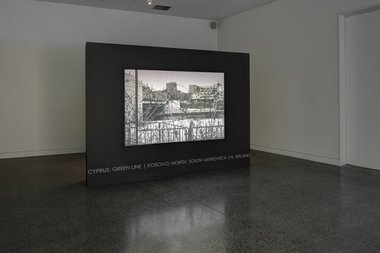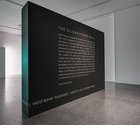John Hurrell – 18 December, 2012
What is interesting is that by themselves many of these images would not hold your attention, being akin to a Magnum form of photojournalism and a bit too obvious. It is the contextual juxtapositioning within the sequencing that makes the work successful, not the individual shots, and the fact that each new image follows a moving vertical line that sweeps from left to right.
Mangere
Danae Stratou
The Globalising Wall
24 November 2012 - 7 February 2013
Danae Stratou‘s installation in Mangere is a section of isolated gallery wall, a dark slab serving as a partition - by itself (unattached to any planar extensions) on the gallery floor. On one side is projected a slide sequence of her photographic images (with an accompanying soundtrack) examining globally the physical / psychological brutality of political divisions, focussing on many varieties of barrier (a range of materials) - and seven locally disrupted political situations - and on the other is presented an evocative text by her partner, economist Yanis Varoufakis. Here is an earlier version.
Stratou’s sequence blends many barriers into one, a serpentine ribbon that seems to continually weave its way across the globe, linking in the viewer’s imagination Palestine with Mexico, Kosovo with Northern Ireland. The surface of this impedance is often covered with graffiti, slogans, murals or wooden crosses and flowers commemorating those who have died attempting to climb over it.
What is interesting is that by themselves many of these images would not hold your attention, being akin to a Magnum form of photojournalism and a bit too obvious. It is the contextual juxtapositioning within the sequencing that makes the work successful, not the individual shots, and the fact that each new image follows a moving vertical line that sweeps from left to right. Despite this ordinariness, even occasional corniness (especially those of cute smiling children) they lift the mood of the theme, reaching a more positive note than what would otherwise be possible. Surprisingly it is not unrelentingly depressing. More matter-of-fact.
With the freestanding partition, the low horizontal text listing the documented sites of divided communities extends like a winding band, passing along underneath the moving slide sequence, and wrapping itself around the corner to carry on around the back. This is obviously an ironic reference to the absolute impassibility of the documented barriers, the finality of them as material obstacles, for the gallery slab is positioned not in the centre of the floor but near the other walls. You have to be really curious (and hopefully you will be) to bother looking behind and discovering Varaufakis’ written contribution - to exploit the bodily freedom the individuals in the photographs are denied.
The appeal of this show lies in the synthesis of immersive sound and image, particularly the rhythm of the loading slides, the way the successive rectangular shots arrive and disappear, the repeated movement of the righthand photographic edge. No one border image is especially memorable, just the overwhelmingly grim theme of negotiated civilian containment and all-pervasive, crushing military power.
In this exhibition are also works by Alex Monteith and Shahriar Asdollah-Zadeh, but as I’d rather discuss them separately - will post something shortly.
John Hurrell



 Two Rooms presents a program of residencies and projects
Two Rooms presents a program of residencies and projects Advertising in this column
Advertising in this column



This Discussion has 0 comments.
Comment
Participate
Register to Participate.
Sign in
Sign in to an existing account.